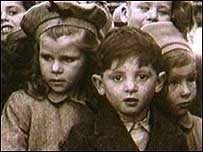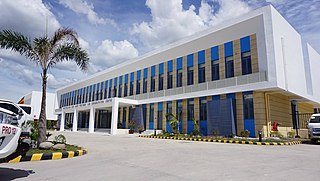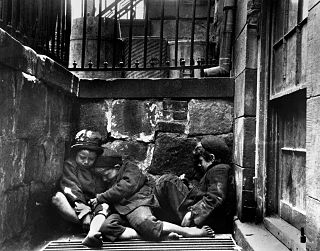
Foster care is a system in which a minor has been placed into a ward, group home, or private home of a state-certified caregiver, referred to as a "foster parent", or with a family member approved by the state. The placement of a "foster child" is normally arranged through the government or a social service agency. The institution, group home, or foster parent is compensated for expenses unless with a family member. In some states, relative or "Kinship" caregivers of children who are wards of the state are provided with a financial stipend.
A behavior modification facility is a residential educational and treatment institution enrolling adolescents who are perceived as displaying antisocial behavior, in an attempt to alter their conduct.
The United States Children's Bureau is a federal agency organized under the United States Department of Health and Human Services' Administration for Children and Families. Today, the bureau's operations involve improving child abuse prevention, foster care, and adoption. Historically, its work was much broader, as shown by the 1912 act which created and funded it:
The said bureau shall investigate and report to [the Department of Commerce and Labor] upon all matters pertaining to the welfare of children and child life among all classes of our people, and shall especially investigate the questions of infant mortality, the birth-rate, orphanage, juvenile courts, desertion, dangerous occupations, accidents and diseases of children, employment, legislation affecting children in the several states and territories.
Foster children in Canada are known as permanent wards. A ward is someone, in this case a child, placed under protection of a legal guardian and are the legal responsibility of the government. Census data from 2011 counted children in foster care for the first time, counting 47,885 children in care. The majority of foster children – 29,590, or about 62% – were aged 14 and under. The wards remain under the care of the government until they "age out of care." This age is different depending on the province.
Kinship care is a term used in the United States and Great Britain for the raising of children by grandparents, other extended family members, and unrelated adults with whom they have a close family-like relationship such as godparents and close family friends because biological parents are unable to do so for whatever reason. Legal custody of a child may or may not be involved, and the child may be related by blood, marriage, or adoption. This arrangement is also known as "kincare" or "relative care." Kinship placement may reduce the number of home placements children experience; allow children to maintain connections to communities, schools, and family members; and increase the likelihood of eventual reunification with birth parents. It is less costly to taxpayers than formal foster care and keeps many children out of the foster care system. "Grandfamily" is a recently coined term in the United States that refers to families engaged in kinship care.
Child protective services (CPS) is the name of an agency in many states of the United States responsible for providing child protection, which includes responding to reports of child abuse or neglect. Some states use other names, often attempting to reflect more family-centered practices, such as department of children and family services (DCFS). CPS is also sometimes known by the name of department of social services, though these terms more often have a broader meaning.
A group home, congregate living facility, care home, adult family home, etc., is a structured and supervised residence model that provides assisted living and medical care for those with complex health needs. Traditionally, the model has been used for children or young people who cannot live with their families or afford their own homes, people with chronic disabilities who may be adults or seniors, or people with dementia and related aged illnesses. Typically, there are no more than six residents, and there is at least one trained caregiver there 24 hours a day. In some early "model programs", a house manager, night manager, weekend activity coordinator, and four part-time skill teachers were reported. Originally, the term group home referred to homes of 8 to 16 individuals, which was a state-mandated size during deinstitutionalization. Residential nursing facilities, also included in this article, may be as large as 100 individuals in 2015, which is no longer the case in fields such as intellectual and developmental disabilities. Depending on the severity of the condition requiring one to need to live in a group home, some clients are able to attend day programs and most clients are able to live normal lifestyles.

A residential treatment center (RTC), sometimes called a rehab, is a live-in health care facility providing therapy for substance use disorders, mental illness, or other behavioral problems. Residential treatment may be considered the "last-ditch" approach to treating abnormal psychology or psychopathology.
The wraparound process is an intensive, individualized care management process for youths with serious or complex needs. Wraparound was initially developed in the 1980s as a means for maintaining youth with the most serious emotional and behavioral problems in their home and community. During the wraparound process, a team of individuals who are relevant to the well-being of the child or youth collaboratively develop an individualized plan of care, implement this plan, and evaluate success over time. The wraparound plan typically includes formal services and interventions, together with community services and interpersonal support and assistance provided by friends, kin, and other people drawn from the family's social networks. The team convenes frequently to measure the plan's components against relevant indicators of success. Plan components and strategies are revised when outcomes are not being achieved.
Child and family services (CFS) is a government or non-profit organisation designed to better the well being of individuals who come from unfortunate situations, environmental or biological. People who seek or are sought after to participate in these homes have no other resource to turn to. Children might come from abusive or neglectful homes, or live in very poor and dangerous communities. There are also agencies that cater to people who have biological deficiencies. Families that are trying to live in stable lives come to non-profit organisations for hope of a better future. Child and family services cater to many different types of people who are all in different situations. These services might be mandated through the courts via a governmental child protection agency or they might be voluntary. Child and family services may be mandated if:
In the United States, Child and Family Services Reviews (CFSR) are conducted by the federal Children's Bureau, within the United States Department of Health and Human Services, to help states improve safety, permanency and well-being outcomes for children and families who receive services through the child welfare system. The Bureau conducts the reviews to ensure conformity with federal child welfare requirements, to determine what is actually happening to children and families in child welfare services, and to assist states in helping children and families achieve positive outcomes. The CFSRs monitor States' conformity with the requirements of title IV-B of the Social Security Act. The first round of reviews took place between 2000 and 2004 and the second round took place between 2007 and 2010. In both rounds, all States were required to implement Program Improvement Plans (PIPs) as part of the review process. The third round of CFSRs took place between 2015 and 2018; a complete aggregate report of those findings has yet to be released.
Attachment-based therapy applies to interventions or approaches based on attachment theory, originated by John Bowlby. These range from individual therapeutic approaches to public health programs to interventions specifically designed for foster carers. Although attachment theory has become a major scientific theory of socioemotional development with one of the broadest, deepest research lines in modern psychology, attachment theory has, until recently, been less clinically applied than theories with far less empirical support. This may be partly due to lack of attention paid to clinical application by Bowlby himself and partly due to broader meanings of the word 'attachment' used amongst practitioners. It may also be partly due to the mistaken association of attachment theory with the pseudo-scientific interventions misleadingly known as attachment therapy. The approaches set out below are examples of recent clinical applications of attachment theory by mainstream attachment theorists and clinicians and are aimed at infants or children who have developed or are at risk of developing less desirable, insecure attachment styles or an attachment disorder.
Institutional abuse is the maltreatment of a person from a system of power. This can range from acts similar to home-based child abuse, such as neglect, physical and sexual abuse, and hunger, to the effects of assistance programs working below acceptable service standards, or relying on harsh or unfair ways to modify behavior. Institutional abuse occurs within emergency care facilities such as foster homes, group homes, kinship care homes, and pre-adoptive homes. Children who are placed in this type of out of home care are typically in the custody of the state. The maltreatment is usually caused by an employee of the facility.

The Arkansas Department of Human Services (DHS) is a state agency of Arkansas, headquartered in Donaghey Plaza South of the Donaghey Complex, a five-story building on the southwest corner of Main Street and 7th Street, in Little Rock.

Foster care is the term used for a system in which a minor who has been made a ward is placed in an institution, group home, relative placement, or private home of a state certified caregiver. The placement of the child is usually arranged through the government or a social-service agency. The institution, group home, or foster parent is paid. The state via the family court and child protection agency stand in loco parentis to the minor, making all legal decisions, while the foster parent is responsible for the day-to-day care of the minor. The foster parent is remunerated by the state for their services.

KVC Health Systems, Inc. (KVC) is a private, nonprofit child welfare and behavioral healthcare organization. When Kansas became the first U.S. state to privatize its child welfare services in 1996, it selected KVC to be one of the nonprofit service providers. As of 2021, KVC Kansas is the only nonprofit organization that has continually been a foster care case management provider for 25 years KVC has provided foster care case management services longer than any other private organization in the U.S.

The New York City Administration for Children's Services (ACS) is a New York City government agency that protects and promotes safety and the well-being of New York City's children and families by providing child welfare, juvenile justice, and early care and education services.
Cottage homes are used in residential child care communities and other Group homes.
Chapin Hall at the University of Chicago is a policy research institution at the University of Chicago that focuses on child welfare and family well-being. Chapin Hall is funded through social service systems, foundations, and non-profit organizations. The organization's focus areas include child welfare and foster care systems, youth homelessness, and community capacity to support children, youth, and families. Chapin Hall is an affiliated research center of the University of Chicago.
Out-of-home placements are an alternative form of care when children must be removed from their homes. Children who are placed out of the home differ in the types and severity of maltreatment experienced compared to children who remain in the home. One-half to two-thirds of youth have experienced a traumatic event leading to increased awareness and growing literature on the impact of trauma on youth. The most common reasons for out-of-home placements are due to physical or sexual abuse, violence, and neglect. Youth who are at risk in their own homes for abuse, neglect, or maltreatment, as well as youth with severe emotional and behavior issues, are placed out of the home with extended family and friends, foster care, or in residential facilities. Out-of-home placements aim to provide children with safety and stability. This temporary, safe environment allows youth to have their physical, mental, moral, and social needs met. However, these youth are in a vulnerable position for experiencing repeated abuse and neglect.





